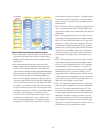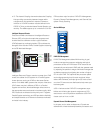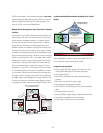53
Key attributes can include
• No single point of failure
• Fast, automatic recovery
– CF: rebuild in surviving CF
– CEC, z/OS, OS/390: restart subsystems on surviving
image
– TM/DBMS: restart in place
• Surviving components absorb new work
• No service loss for planned or unplanned outages
• Near unlimited, plug-and-play growth capacity
Linux on zSeries
Linux and zSeries are a great team. Linux has the same
appearance and application programming interfaces no
matter what platform it is running on, since it is designed
to be platform-independent. When Linux is run on a
zSeries server it inherits the legendary qualities of service
that businesses world-wide rely on for hosting their most
important workloads. Linux is open standards-based, sup-
porting rapid application portability and can be adapted
to suit changing business needs. The fl exibility and open-
ness of Linux make it very popular with developers, whose
contributions endow Linux with an extensive and diverse
application portfolio. zSeries servers enable massive scal-
ability within a single server, either horizontally or vertically.
Hundreds of Linux images can run simultaneously, provid-
ing unique server consolidation capabilities while aiding in
reducing both cost and complexity.
Of course, no matter which Linux applications are brought
to the zSeries platform, they can all benefi t from high-
speed access to the applications and corporate data that
reside on zSeries.
IBM developed the code that enables Linux to run on
zSeries servers, and made it available to the Open Source
community. The term used to describe this enabling code
is “patches.”
To help eliminate the need for an external 2074 Console
controller and associated consoles, an administrator may
utilize the Hardware Management Console (HMC) func-
tions “Integrated 3270 Console Support” for operating
z/VM images, and “Integrated ASCII Console Support” to
operate Linux images.
z890 Support for Linux


















